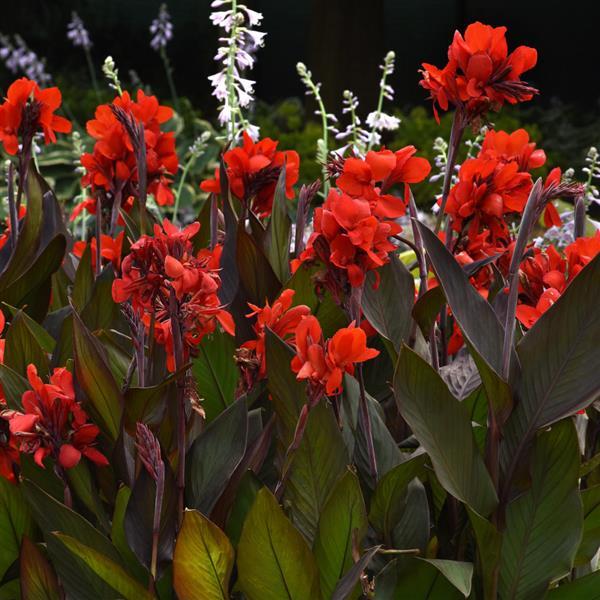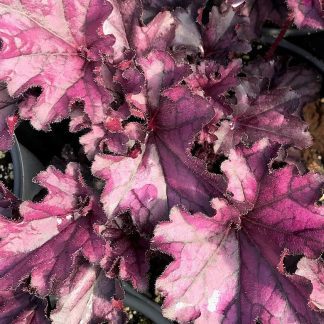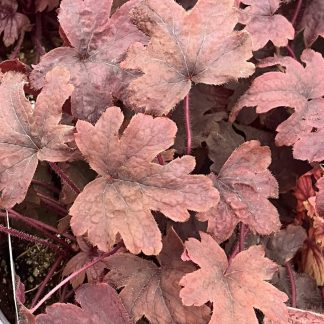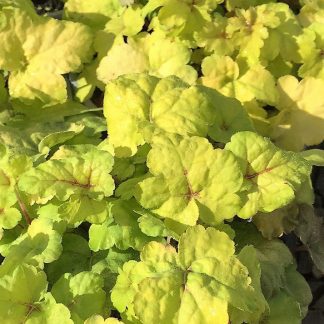Description
Cannova® Bronze Scarlet Canna: A Fiery Focal Point for Every Garden
Welcome Aboard
We all crave spark and motion in our gardens. In other words, we want plants that look alive, feel alive, and make us feel alive right beside them. Cannova Bronze Scarlet does that and more. With broad bronze leaves and blazing scarlet blooms, this canna stands like a living torch. Yet it asks very little from us. Sun, water, and a bit of food keep it glowing from the first warm days of late spring until the last chill of fall. After more than one season with this plant, you may wonder how you ever gardened without it.
Meet Cannova Bronze Scarlet
A Quick Snapshot
- Botanical Name: Canna × generalis ‘Cannova Bronze Scarlet’
- Family: Cannaceae
- Height/Spread: 30–48 in. tall, 24–30 in. wide
- Hardiness: USDA Zones 8–11 (grown as an annual in cooler zones)
- Foliage: Deep bronze to chocolate-brown, lance-shaped, glossy
- Flowers: Vibrant scarlet-red with faint orange undertones
- Bloom Season: Early summer to frost
- Special Power: Thrives in heat, humidity, and even shallow water
What Sets It Apart
Instead of plain green foliage, Cannova Bronze Scarlet shows off bronzy leaves that frame the flowers like dark satin. The blooms themselves are held high on sturdy stems, which means we get a clear view from across the yard. Bees and butterflies press in for nectar. Hummingbirds, too, dart from spike to spike. But most of all, we enjoy a steady parade of color with hardly any deadheading.
A Closer Look at the Show (Description)
Striking Foliage
The leaves look almost tropical, yet they hold their shape in strong wind. Each blade unfurls in early spring, glossy and dark. Sunlight bounces off the surface, making the bronze appear lighter at midday and deeper at dusk. In mixed beds, the leaves give balance to bright neighboring flowers. They also hide spent blooms, so our display always feels tidy.
Flamenco-Red Blooms
Picture narrow petals, flaring like red flags at the top of each stem. New buds appear as older flowers fade, so the plant never seems tired. The color sits on the warm side of red. In morning light it can look soft and rosy; in late afternoon it turns into deep flame. The petals resist light rain and do not shred in heavy downpours. That makes this canna perfect for climates where sudden storms roll in.
Growth Habit & Presence
Cannova Bronze Scarlet tops out at around three to four feet. It rarely needs staking because the stems are thick near the base. The plant grows from rhizomes that push new shoots from below. Over one summer, a single clump can triple in width, giving us a lush display without extra work.
How Cannova Bronze Scarlet Fits Into Our Space
Bold Containers
We can tuck one rhizome into a 12-inch pot and get quick results. For a taller statement, choose a 16- or 20-inch pot and underplant with trailing sweet potato vine, creeping jenny, or wave petunias. The bronze leaves pair well with chartreuse, silver, and hot pink.
Water Features and Rain Gardens
Canna naturally handles wet roots. We can sink the pot halfway into a pond shelf or keep it in a boggy corner where little else thrives. Instead of drowning, the rhizomes fatten up. The plant then pumps out more leaves and bigger blooms.
Mixed Borders
Picture Bronze Scarlet at the back of a sunny bed. In front, plant zinnias, salvia, or lantana. The canna’s dark leaves anchor the scene, giving color depth. After more than a month, everything knits together, and we have a living tapestry that looks rich but never busy.
Pollinator Haven
Butterflies love red flowers, and hummingbirds can’t resist. While Cannova Bronze Scarlet is not a major nectar factory like some salvias, the steady bloom keeps visitor traffic high. In other words, add this canna and you invite winged friends all season long.
How to Care for Cannova Bronze Scarlet
Light Needs
Give full sun for best color—at least six hours daily. In very hot regions, light shade in late afternoon prevents leaf scorch.
Soil and Planting
- Texture: Loose, fertile, and rich in organic matter.
- pH: Slightly acidic to neutral (6.0–7.0).
- Drainage: Even though canna loves moisture, stagnant water without oxygen can rot the rhizomes. A mix that holds water yet drains well works best.
To plant, dig a hole twice as wide as the rhizome and about four inches deep. Lay the rhizome horizontally, eyes up. Cover and firm gently. Water well.
Watering Rhythm
Keep soil moist, especially during the first month. After roots settle, Cannova Bronze Scarlet can take short dry spells. However, regular deep drinks every three or four days in summer push bigger blooms. In containers, check daily. If the top inch feels dry, water until it flows out of the bottom.
Feeding & Grooming
- Fertilizer: A balanced 10-10-10 or 14-14-14 slow-release granule at planting feeds for three months. Midseason, side-dress with compost or liquid feed every two weeks.
- Deadheading: Snip spent flower stalks just below the last bloom. This keeps energy flowing to new buds.
- Leaf Care: Remove yellowing lower leaves to keep air moving.
Seasonal Rhythm
In Zones 8–11, rhizomes stay in the ground year-round. They rest a bit in winter, then sprout once soil hits 60 °F. In cooler zones, we lift rhizomes before the first killing frost. Shake off soil, let them dry, and store in peat moss at 45–50 °F. Replant when danger of frost passes.
Pest & Disease Watch
- Pests: Japanese beetles can chew leaves. Hand-pick or use traps set away from the bed. Canna leaf rollers may tunnel inside rolled leaves; cut and destroy rolled foliage.
- Diseases: Fungal rust shows as orange spots. Remove infected leaves and keep water off foliage. If needed, apply an organic copper spray.
Growing With Purpose
Companion Planting
Pair Cannova Bronze Scarlet with feathery grasses like Pennisetum ‘Rubrum’. The soft plumes play against the bold canna leaves. For a cooling note, tuck in blue salvia or purple verbena. This partnership gives color contrast and draws diverse pollinators.
Edible Adventure
Canna rhizomes are edible after long boiling. Many cultures use them for starch. That said, Bronze Scarlet is grown for looks, not large tubers. Still, if you lift rhizomes for winter, you can sample a slice. The taste is like mild potato.
Eco-Benefits
Canna roots filter water. In constructed wetlands, they help clean runoff. So by adding Cannova Bronze Scarlet near a downspout or rain garden, we improve water quality while adding color.
Troubleshooting at a Glance
| Problem | Likely Cause | Simple Fix |
|---|---|---|
| Yellow leaves | Overwatering or nutrient loss | Let soil dry slightly; feed with balanced fertilizer |
| Brown tips | Drought stress or salt build-up | Deep water; flush pot once a month |
| Few blooms | Low light or poor feeding | Move to sun; apply liquid bloom booster |
| Holes in leaves | Caterpillars or beetles | Hand-pick; cover with lightweight netting |
Propagation & Renewal
Dividing Rhizomes
After more than two seasons, clumps may crowd. Lift in early spring or late fall. Use a clean knife to slice sections with at least one eye each. Dust cuts with cinnamon to reduce rot, then replant or pot up extras for friends.
Starting From Seed
Cannas set seed in round, hard pods. To speed germination, nick the coat with a file and soak overnight in warm water. Sow in a moist mix at 70 °F. Seedlings bloom the second year and may vary from the parent, so this route is fun but slower than division.
Keeping Stock Healthy
Rotate potting soil every year. Discard any rhizome that smells sour or feels mushy. A healthy piece feels firm, like a fresh carrot.
Design Inspiration
Color Echo
Match the scarlet blooms with red coleus in shade or geraniums in sun. Then repeat the bronze leaf color with copper garden art or clay pots. This echo makes the whole scene feel planned.
Tropical Vibe on a Patio
Group three large pots: one with Cannova Bronze Scarlet, one with banana, and one with purple fountain grass. Slip trailing gold lysimachia around each rim. Add a small bistro set, and we have a vacation corner without leaving home.
Poolside Drama
Plant a row along the far edge of a pool or pond. The reflection doubles the color, and the floating blooms give the water a fire-and-ice effect when the sky turns blue above.
Frequently Asked Questions
Does Cannova Bronze Scarlet spread aggressively?
No. It grows in tidy clumps. It will fill out, but it will not invade like bamboo.
Can I grow it indoors?
Yes, if you have very bright light or a sunroom. A south-facing window works best. Keep soil moist and feed monthly.
Is it deer-resistant?
Deer usually look elsewhere. The thick leaves taste starchy, not sweet. In heavy pressure areas, spray a safe deer repellent every few weeks.
Will frost kill the plant?
Frost kills the top growth, but the rhizomes survive in Zones 8–11. In colder zones, lift and store as described above.
We Grow, We Learn, We Bloom Brighter Together
When we choose Cannova Bronze Scarlet, we invite heat, color, and life into our gardens. We watch bronze leaves shimmer. We watch red blooms dance. We share the space with butterflies, hummingbirds, and friends who stop to ask, “What is that gorgeous plant?” Growing it is simple. Caring for it is joyful. Most of all, the rewards come fast and stay long. So let’s plant boldly, water well, and let the fires of Bronze Scarlet burn bright in every corner we call home.




